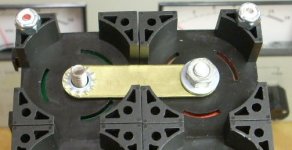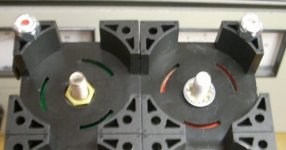after having some problems with leaking cells in my original packaging, i was very hopeful when i heard about the new PSI built assembly parts available from andyh through his website http://www.rechargeablelithiumpower.com
the blocks have turned out to be everything i hoped for. there are a photos of the blocks on his website but i thought i would post a few more detailed ones here.
the blocks snap together into any configuration desired and space the cells for cooling and protection from cells shorting together. the seats in the blocks are about .25 mm larger than the o.d. of my cells, so they slop around a bit. there may be manufacturing tolerances that make the loose fit necessary; and i would not want to rely just on the fit of the blocks to the cells to hold the pack together. i drilled out some holes in the four corners of the block assembly and cut some 8-32 threaded shafting to length, then used locking nuts to hold the pack together with this additional frame. this makes the pack very solid.View attachment 5
 View attachment assembled 6 cell pack.jpg
View attachment assembled 6 cell pack.jpg
the blocks have turned out to be everything i hoped for. there are a photos of the blocks on his website but i thought i would post a few more detailed ones here.
the blocks snap together into any configuration desired and space the cells for cooling and protection from cells shorting together. the seats in the blocks are about .25 mm larger than the o.d. of my cells, so they slop around a bit. there may be manufacturing tolerances that make the loose fit necessary; and i would not want to rely just on the fit of the blocks to the cells to hold the pack together. i drilled out some holes in the four corners of the block assembly and cut some 8-32 threaded shafting to length, then used locking nuts to hold the pack together with this additional frame. this makes the pack very solid.View attachment 5

 View attachment assembled 6 cell pack.jpg
View attachment assembled 6 cell pack.jpg



